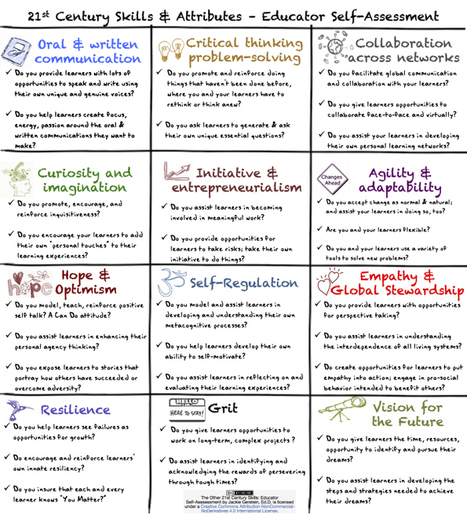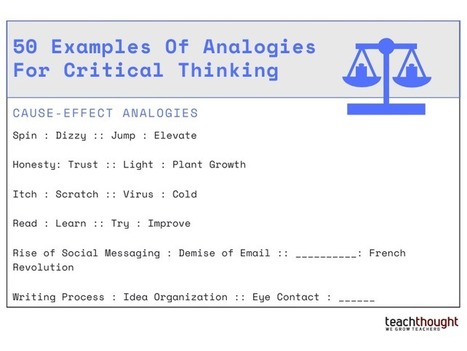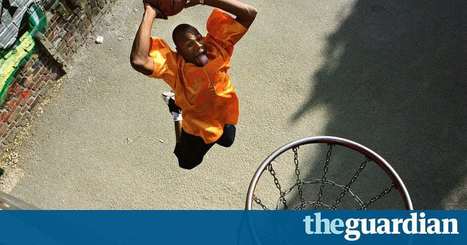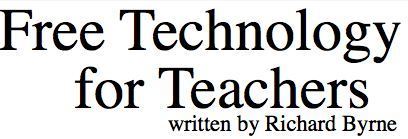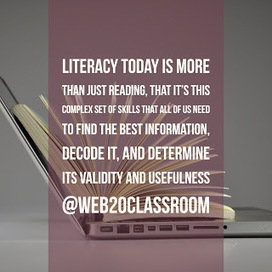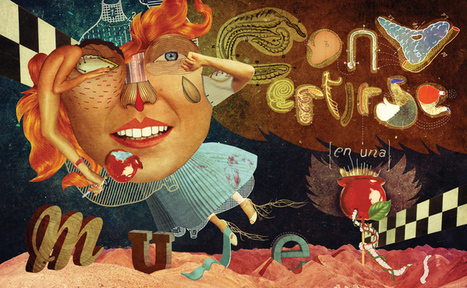Mistakes are a natural part of learning, but students cannot develop into critical thinkers if they regularly freeze out of the fear of making a mistake. As educators, we can shift the culture of our classrooms to embrace mistakes, and one way to do this is through mistake analysis, one of several powerful but practical strategies I share in my book, Thinking Like a Lawyer: A Practical Framework to Teach Critical Thinking to All Students. As a math-teacher-turned-attorney, I wrote this book and started my organization, thinkLaw, to help educators seamlessly incorporate critical thinking into their curriculum.
Get Started for FREE
Sign up with Facebook Sign up with X
I don't have a Facebook or a X account
 Your new post is loading... Your new post is loading...
 Your new post is loading... Your new post is loading...

Andres Gomez's curator insight,
September 21, 2017 11:46 AM
To develop critical thinking is one of the most complex task to do for teacher in terms of education. Taking into account the history of education in Colombia it is on the principals factor that we as teachers should try to improve in our students in a view of the fact that the Colombia education model do not permit involve our students in whole process to be thinkers, but the principal difficult is, How to do it?
Jeannette Delamoir's curator insight,
May 21, 2017 7:26 PM
Another great tool for strengthening students' critical thinking. (Thanks, Kris, that's two great sources from your selection!)

Nguyet Vi Truong (Rose)'s curator insight,
May 24, 2017 8:25 AM
A great thought-provoking questions to create critical thinking
Samantha's curator insight,
June 1, 2017 9:50 AM
Critical thinking is an essential skill, and the journalistic question are always a great way (and subject) on which to practice critical thinking. I really appreciate how detailed this outline is. I would love to make a poster of it. It is exactly the sort of thing I would love to have up in the classroom, as a guide for me as well as my students.

Character Minutes's curator insight,
May 5, 2017 12:34 PM
Great tool for teachers to use in the classroom.
Julian F Calvo's curator insight,
February 19, 2020 9:59 AM
This is an excellent idea for us to check how we can implement our topics and also, how learners can be interested on due to the fact that we are taking into account all the benefits they can have (this as an example of the WH questions) and also since they can discuss about what they like to learn and share in classes. In adition, thi is something I can implement in classes since learners will have the opportunity to improve this speaking skill trhough the discussion of this kind of topics and also, the ones their are interested on. Finally, students will be able to participate more ought to the increase of motivation they will have since our duty is to encourage them to use the second language they are learning.

Harold Quintero's curator insight,
September 26, 2020 2:37 AM
This is a very complete guide related to critical thinking questions that can allow us to help our students reflecting on the content we present them. These questions are also very useful for teachers in development to keep in mind while planning classes and preparing the material they are presenting to their students as it leads them to better select and adapt the content to students' needs and interests and have them engaged.

Oskar Almazan's curator insight,
March 14, 2017 8:21 AM
Team building games offer students fun opportunities to hone critical skills for success in the modern workplace. Students (and future employees!) that value teamwork are more motivated and creative. They’re also better at problem solving and communicating with one another and have a higher level of trust. We already know students love working in groups. Why not make a game of it?

Andrea Mejia Medina's curator insight,
March 18, 2017 12:10 AM
Critical thinking is the most important skill to develop, since in these times of information at hand, we cannot believe everything we see, read, and hear, and that is why it is important to develop this ability as it allows us to be alert and question everything that comes from these means of information. Is a skill that moves a student from concrete ideas to abstract and inferred concepts. Critical thinking allows us to analyze outcomes, compare ideas, identify parallels, sequence events, synthesize information and draw conclusions from a given body of knowledge. Whether it is the proof behind a mathematics formula or an implied tone in an essay, critical thinking skills enable students to solve problems in the real world and on exams in school. Meghan Moll (2014) suggests five tools to develop the critical thinking skills necessary for success on every high school or college test and assignment. 1. Brain games: Recently, websites dedicated to training your brain have enjoyed increased popularity. Lumosity, for example, provides games that aid in improving memory and problem-solving. From timed matching games to order sequence memorization, websites like this can aid in cognition and the ability to ask, "What is the next step?" This skill is critical to learning how to approach complex problems on standardized tests like the ACT and SAT. Rather than playing time-wasting games when you have a lull in your day, search online for brain teasers and peruse the plethora of brain games at your fingertips. 2. Logic puzzles: Before the Internet, puzzles intended to exercise your brain were published in books. Collections of crossword puzzles, logic problems, riddles, sudoku, word problems and word searches can be found at your local bookstore or library. The puzzles in these books are a wonderful strategy to activate different parts of your brain for a round or two of mental gymnastics, and many collections even discuss what each puzzle is meant to target within the mind. 3. Board games: This suggestion may seem strange at first, but do not balk. Choose board games that require more than luck – namely, strategy – for players to win. Any game where players must carefully consider their next move, recognize patterns and remember details will aid in honing critical thinking skills. Certain games like Rubik’s Cube are single-player, while others involve multiple people. Checkers, chess and Mastermind are two-player games that challenge you to plan several steps ahead. Games like Boggle and Scrabble require analyzing information quickly and formulating words, while Clue and Risk test and strengthen your ability to anticipate and react to others’ moves, as well as infer motives. 4. Journaling: Daily reflection – such as maintaining a journal – is a simple way to revisit your day, but it is also a fantastic opportunity to explore ideas. Writing encourages you to expand upon your thoughts and form connections. A journal forces you to slow down and focus on just one or two ideas at a time, which hectic schedules don't otherwise allow. Use your journal to record important ideas and questions and narratives about your life. 5. Book clubs: Students who read for understanding find it far easier to think critically than those who rush to finish. Analyzing a book requires you to delve deeper and ponder complex questions. When reading, think about why the book was written the way it was, what motivates certain characters, and how plot developments may be symbols of foreshadowing. Locate a book club to hone these skills. You will read works you otherwise may not have, and you will learn to examine character development, plot, symbolism and a whole host of other features. 3 
Character Minutes's curator insight,
May 5, 2017 12:47 PM
Great games to use with "ME Leadership" (Marks of Excellence)

David Baker's curator insight,
February 17, 2015 10:54 AM
The power of the Infographic is that it references both teacher and student actions and habits. I have shared it with my teachers. This might become a solid self-assessment tool for coaching conversations with teachers. 
Kristen McDaniel's curator insight,
April 3, 2015 12:05 PM
Interesting graphic with some great ideas on interpreting 21st century skills as they pertain to teaching |

David Baker's curator insight,
February 17, 2015 10:54 AM
The power of the Infographic is that it references both teacher and student actions and habits. I have shared it with my teachers. This might become a solid self-assessment tool for coaching conversations with teachers. 
Kristen McDaniel's curator insight,
April 3, 2015 12:05 PM
Interesting graphic with some great ideas on interpreting 21st century skills as they pertain to teaching
Sample Student's curator insight,
May 5, 2015 10:14 PM
We often ask our students to create annotated bibliographies, and this focuses on their capacity to evaluate and make decisions about the validity, reliability and relevance of sources they have found. using Scoop.it, we can ask them to do much the same thing, but they will publish their ideas for an audience, and will also be able to provide and use peer feedback to enhance and tighten up their thinking. This is relevant to any curriculum area. Of course it is dependent on schools being able to access any social media, but rather than thinking about what is impossible, perhaps we could start thinking about what is possible and lobbying for change.
Sample Student's curator insight,
May 5, 2015 10:18 PM
We often ask our students to create annotated bibliographies, and this focuses on their capacity to evaluate and make decisions about the validity, reliability and relevance of sources they have found. Using Scoop.it, we can ask them to do much the same thing. But they will publish their ideas for an audience, and will also be able to provide and use peer feedback to enhance and tighten up their thinking. This is relevant to any age, and any curriculum area. Of course it is dependent on schools being able to access social media. But rather than thinking about what is impossible, perhaps we should start thinking about what is possible, and lobbying for change. Could you use a Scoop.it collection as an assessment task? |




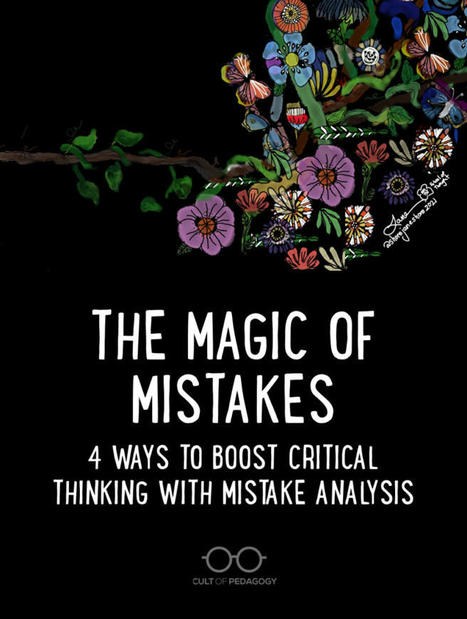


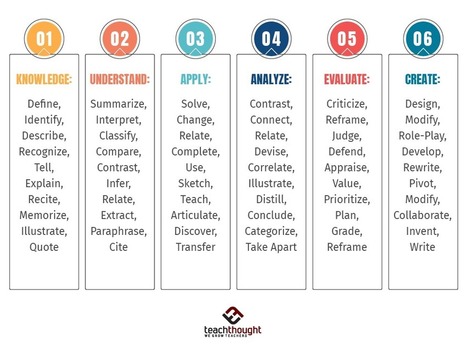
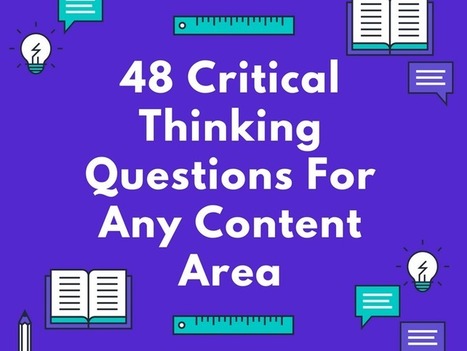

![The Critical Thinking Skills Cheatsheet [Infographic] | Professional Learning for Busy Educators | Scoop.it](https://img.scoop.it/nmWSNJlxhxIS0OiXOvHYdzl72eJkfbmt4t8yenImKBVvK0kTmF0xjctABnaLJIm9)
![The Critical Thinking Skills Cheatsheet [Infographic] via GDC | Professional Learning for Busy Educators | Scoop.it](https://img.scoop.it/sxh5AIjI1PEa9kmMwj3gGjl72eJkfbmt4t8yenImKBVvK0kTmF0xjctABnaLJIm9)

